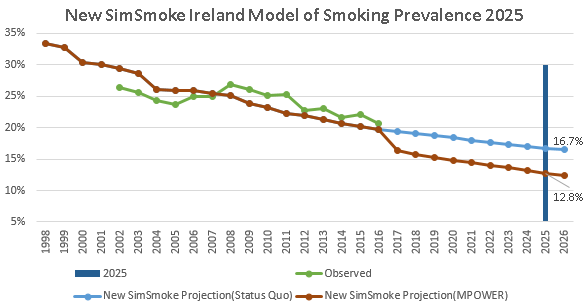Home
Issues
Aims and Scope
Open Access
Editorial Board
Indexing
Why publish with us
Contact us
Instructions to authors (PDF)
Manuscript Types
Manuscript Formatting
How to submit
Preprints
Special Publications & Reprints
Authorship & COI
Principles of Transparency Checklist
Data Policies
Publication Ethics and Publication Malpractice Statement
The effect of tobacco control policies on smoking prevalence using the SimSmoke Ireland model: influence of interventions 2010-2016 on reaching End Game 2025
1
TobaccoFree Research Institute Ireland, Ireland
2
Georgetown University, United States of America
Publication date: 2018-03-01
Tob. Induc. Dis. 2018;16(Suppl 1):A42
KEYWORDS
TOPICS
ABSTRACT
Background:
This study estimates the impact of tobacco control policies implemented between 1998 and 2016 on smoking prevalence reduction in Ireland by 2016. It also assesses if Ireland at 2016 has outperformed the projection from the previous model based on the data between 1998 and 2010. If yes, what contributed to the outperformance and how will it help Ireland to get closer to Tobacco Free Ireland (TFI) 2025 (End Game)?
Methods:
SimSmoke, the dynamic simulation model of tobacco control policy, was adapted to examine the present impact of Irish tobacco control policies on smoking prevalence, through initiation and cessation, and smoking-attributable deaths and to make predictions for the future.
Results:
The previous model projection for Ireland 2016 male smoking prevalence was 25% under Status Quo and 21% under all MPOWER policies. The new model predicts that the male smoking rate for ages 18 and older of 33.4% in 1998 falls to 19.7% in 2016 achieving a 41% reduction, which matches observed. The outperformance could be explained by price increase, stronger health warnings, improved youth 'access' enforcement and improved smoking cessation treatment between 2011 and 2016.

[New SimSmoke Ireland Model of Smoking Prevalence]
Conclusions:
Ireland smoking prevalence in 2016 has outperformed the old model prediction under all MPOWER policies. Although between 2011 and 2016 Ireland has improved in the areas mentioned above, they did not reach the highest levels according to MPOWER standard, which implies two points. One is that there is more room for Ireland to further reduce smoking prevalence by fully applying policies according to MPOWER. Some policies are not fully accounted for by the model, which have been introduced in the period, such as the ban on smoking in cars where children are present and plain packaging legislation, but new policies are needed to achieve TFI.
This study estimates the impact of tobacco control policies implemented between 1998 and 2016 on smoking prevalence reduction in Ireland by 2016. It also assesses if Ireland at 2016 has outperformed the projection from the previous model based on the data between 1998 and 2010. If yes, what contributed to the outperformance and how will it help Ireland to get closer to Tobacco Free Ireland (TFI) 2025 (End Game)?
Methods:
SimSmoke, the dynamic simulation model of tobacco control policy, was adapted to examine the present impact of Irish tobacco control policies on smoking prevalence, through initiation and cessation, and smoking-attributable deaths and to make predictions for the future.
Results:
The previous model projection for Ireland 2016 male smoking prevalence was 25% under Status Quo and 21% under all MPOWER policies. The new model predicts that the male smoking rate for ages 18 and older of 33.4% in 1998 falls to 19.7% in 2016 achieving a 41% reduction, which matches observed. The outperformance could be explained by price increase, stronger health warnings, improved youth 'access' enforcement and improved smoking cessation treatment between 2011 and 2016.

[New SimSmoke Ireland Model of Smoking Prevalence]
Conclusions:
Ireland smoking prevalence in 2016 has outperformed the old model prediction under all MPOWER policies. Although between 2011 and 2016 Ireland has improved in the areas mentioned above, they did not reach the highest levels according to MPOWER standard, which implies two points. One is that there is more room for Ireland to further reduce smoking prevalence by fully applying policies according to MPOWER. Some policies are not fully accounted for by the model, which have been introduced in the period, such as the ban on smoking in cars where children are present and plain packaging legislation, but new policies are needed to achieve TFI.
CITATIONS (1):
1.
Towards a Tobacco Free Ireland—scaling up and strengthening quit smoking behaviour at population level
Naomi Petty-Saphon, Paul Kavanagh
Irish Journal of Medical Science (1971 -)
Naomi Petty-Saphon, Paul Kavanagh
Irish Journal of Medical Science (1971 -)
Share
RELATED ARTICLE
We process personal data collected when visiting the website. The function of obtaining information about users and their behavior is carried out by voluntarily entered information in forms and saving cookies in end devices. Data, including cookies, are used to provide services, improve the user experience and to analyze the traffic in accordance with the Privacy policy. Data are also collected and processed by Google Analytics tool (more).
You can change cookies settings in your browser. Restricted use of cookies in the browser configuration may affect some functionalities of the website.
You can change cookies settings in your browser. Restricted use of cookies in the browser configuration may affect some functionalities of the website.

